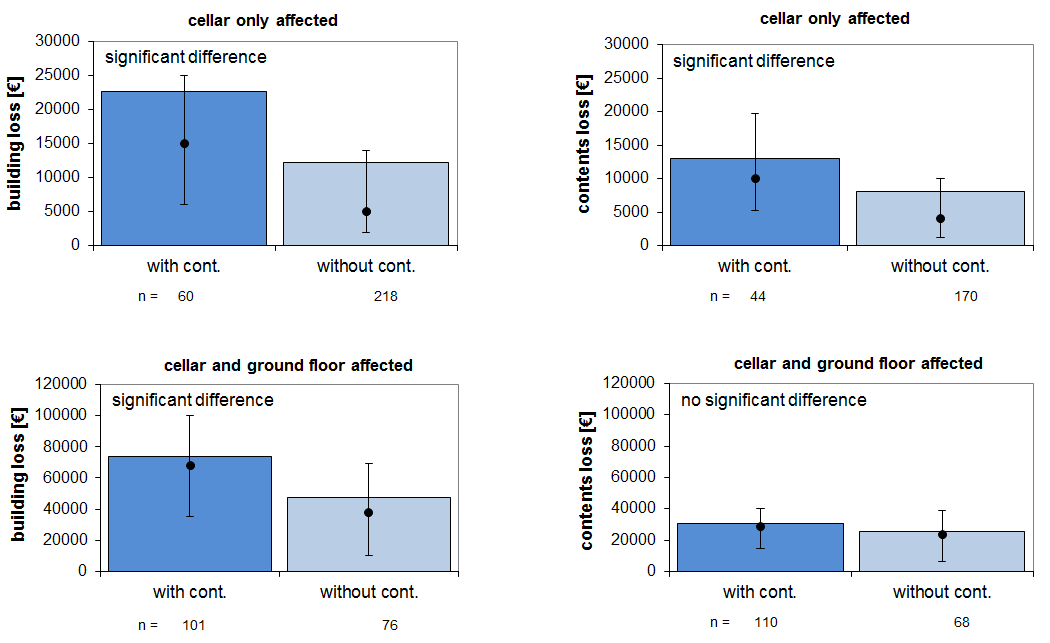Publication:
Articles in scientific journals:
Bubeck, P., Botzen, W.J.W., Kreibich, H., J.C.J.H. Aerts (2012). Detailed insights into flood-coping appraisals. Global Environmental Change - Human and Policy Dimensions, under review.
Bubeck, P., Botzen, W.J.W., Kreibich, H., J.C.J.H. Aerts (2012). Long-term development and effectiveness of private flood mitigation measures: An analysis for the German part of the river Rhine. Natural Hazards and Earth System Sciences, under review.
Bubeck, P., H. de Moel, L.M. Bouwer, J.C.J.H. Aerts, 2011. How reliable are projections of future flood damage? Natural Hazards and Earth System Sciences 11, 3293-3306.
Kreibich, H., Christenberger, S., and Schwarze, R., 2011. Economic motivation of households to undertake private precautionary measures against floods. Nat. Hazards Earth Syst. Sci., 11, 309-321, doi:10.5194/nhess-11-309-2011.
Book chapter:
Kreibich, H., Elmer, F., Gericke, A., Merz, B. (2012). Veränderungen des Hochwasserrisikos und Konsequenzen für das Risikomanagement. In: U. Grünewald, O. Bens, H. Fischer, R.F. Hüttl, K. Kaiser, A. Knierim (Hrsg.) Wasserbezogene Anpassungsmaßnahmen an den Landschafts- und Klimawandel. Schweizerbart, Stuttgart, 228–237
Conference presentations:
Bubeck P, Kreibich.H., 2011 Hochwasserrisikomanagement – von der Vorsorge zur Anpassung. Symposium Wasserbezogene Anpassungsmaßnahmen an den Landschafts- und Klimawandel in Deutschland. Großräschen/Lausitz, Germany, 22-24 June 2011.
Bubeck P, Kreibich.H., 2011 Hochwasserrisikomanagement – von der Vorsorge zur Anpassung. 24. Treffen des Arbeitskreises Naturgefahren/-risiken der Deutschen Gesellschaft für Geographie, 31.08.2012, Bonn
P. Bubeck, H. Kreibich, W.J.W. Botzen, and J.C.J.H. Aerts (2011) Spatial and temporal spread of flood mitigation measures implemented by private households along the Rhine and their effectiveness. European Geoscience Union General Assembly 2012. 22 – 27 April 2012 in Vienna.
P. Bubeck, H. Kreibich, W.J.W. Botzen, and J.C.J.H. Aerts (2012). Are private flood mitigation measures successfully contributing to contemporary integrated flood risk management in Germany? Global Risk Forum (GRF), 26.-30. August 2012, Davos.
H. Kreibich and P. Bubeck (2012) Adaptation to global change: Can private households contribute to flood risk reduction in German Cities? International Geographical Congress (IGC). 26.-30. August, Cologne.
Bubeck, P., H. Kreibich, E. Penning-Rowsell, F. Klijn & W. Botzen (2012). Explaining differences in flood risk management approaches in Europe and the USA – A comparative analysis. FLOODrisk2012 conference, November 2012, Rotterdam.
Natural hazards and especially floods have caused severe economic damages in Europe in the last few decades. Further increases in flood risk are expected due to the effects of climate change and ongoing socio-economic development in risk-prone areas. To address the observed and projected increase in flood risk, non-structural flood mitigation measures like flood zoning or building precautionary measures, are increasingly seen as a promising adaptation strategy, complementary to technical flood defense systems. In addition to the associated economic benefits, the implementation of non-structural flood mitigation measures also accounts for the possibility that flood defenses can fail, and thus prepares for such unexpected crisis situations. However, even though non-structural flood mitigation measures have received renewed attention in recent years, information on their operational use and effectiveness is still scarce. For cost-effective flood risk management, more (quantitative) information about the damage reducing effect of mitigation measures in different flood situations, as well as the conditions under which such measures are operationally used, are needed.
The objective of this project, which is part of the Dutch research programme ‘Knowledge for Climate’ , is to assess the potential of flood mitigation measures. Most effective mitigation measures will be identified for different flood situations. Additionally, successful strategies for the promotion of such measures will be described by means of an international comparison.
In order to address the objectives of this project, the following three research questions have been formulated:
- What are the damage reducing effects of various non-structural mitigation measures in different flood situations?
- To what extent are the measures operationally used in different countries with their different political, legal, and societal conditions?
- What strategies are used to increase the operational use of such measures in different countries?




